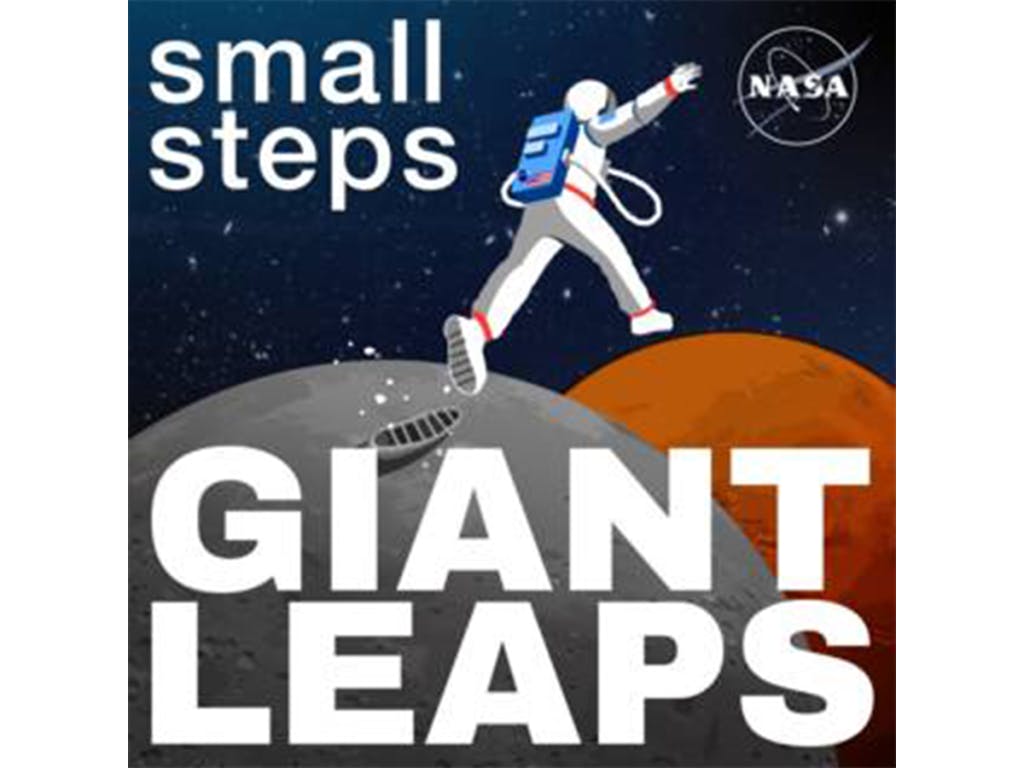Discover Small Steps, Giant Leaps
Small Steps, Giant Leaps

Small Steps, Giant Leaps
Author: National Aeronautics and Space Administration (NASA)
Subscribed: 397Played: 7,343Subscribe
Share
© NASA/APPEL Knowledge Services
Description
NASA’s technical workforce put boots on the Moon, tire tracks on Mars, and the first reusable spacecraft in orbit around the Earth. Learn what’s next as they build missions that redefine the future with amazing discoveries and remarkable innovations.
163 Episodes
Reverse
A solar sail uses light particles from the Sun to move through space without needing a single drop of fuel. NASA is demonstrating the lightweight technology that could open doors to low-cost missions to deep space.
Dr. Jennifer Edmunson explains what it takes to simulate Moon and Mars dust on Earth, and lessons learned from preparing to build habitats on other worlds.
There’s a program at NASA that taps into the power of the public to solve some of the toughest problems in space exploration. It’s called Centennial Challenges, a prize competition that has awarded more than $24 million to hundreds of people ranging from academics, startup founders, small business owners, and independent inventors from across the U.S. and 86 countries.
On September 17, 2025, NASA announced that the number of exoplanets, planets outside our solar system, tracked by NASA has reached 6,000. In the three decades since the groundbreaking detection of exoplanet 51 Pegasi b, the first confirmed planet orbiting a Sun-like star, astronomers have concluded that exotic worlds are everywhere.
A steel vacuum chamber 50 stories deep at NASA’s Glenn Research Center lets researchers simulate near-weightlessness by letting test hardware freefall for 5.18 seconds.
From black holes to star clusters, scientists are turning space data into sound with a process called sonification. Dr. Kimberly Arcand, visual scientist with the Harvard-Smithsonian Center for Astrophysics, joins us to explore how data sonification lets more people experience the cosmos and give researchers a new way to interpret science one note at a time.
StarBurst, a satellite the size of a washing machine, aims to detect the initial blast of gamma-rays, the most powerful bursts of energy in the universe. These huge explosions can occur when dense neutron stars collide, forging metals like gold and platinum. These metals are some of the building blocks of planets — like Earth.
The Hubble Space Telescope has changed humanity’s understanding of the universe. Now in orbit for 35 years, it remains a remarkable feat of engineering.
Fighting wildland fires by air at night is especially hazardous. NASA’s ACERO Project aims to make firefighting safer, day or night, with drones and smarter airspace management.
IXPE, or the Infrared X-ray Polarimetry Explorer, is NASA’s first space telescope dedicated to studying X-ray polarization from extreme objects like black holes and quasars.
Big or small, we all take risks nearly every day. But how does NASA manage it? Dr. Mary Skow, NASA’s first agency risk management officer, explains.
NASA’s Air Traffic Management-eXploration Project aims to accommodate the growing demand of traditional and emerging aircraft that share the friendly skies.
NASA's SPHEREx mission will map 450 million galaxies like we’ve never seen before.
What can the auroras tell us about our planet’s relationship with the Sun? NASA’s EZIE mission looks into it.
NASA’s design labs are where engineers develop concepts for missions and scientific instruments.
Flying taxis? NASA is working on it.
Originally a fashion designer, Paula Cain is a NASA thermal blanket technician, working to protect spacecraft from the extremes of space.
NASA engineers turn dreams into reality, solving complex challenges to push exploration forward. From landing rovers on Mars to advancing deep space missions, their ingenuity makes it all possible. This episode with Chief Engineer Joe Pellicciotti and Deputy Chief Engineer Katherine Van Hooser celebrates the innovation, dedication, and impact of NASA’s engineering community.
Ever wondered what it takes to capture NASA’s most breathtaking moments? From rocket launches to behind-the-scenes astronaut training, Bill Ingalls, senior contract photographer for NASA Headquarters has spent decades framing history through his lens. In this episode, we dive into his journey, how he and his team prepare for assignments, and the importance of visual storytelling.
What if we could get rid of lengthy waitlists for organ transplants? Well, imagine 3-D printing a kidney from your own stem cells. That would reduce the chances your body rejects it. That’s the sort of groundbreaking medical research astronauts are conducting aboard the International Space Station. Other research includes understanding the stress spaceflight places on not just the body, but also the mind. There’s a plethora of human factors to consider as humanity prepares to embark on deep space missions. What we learn from spaceflight medicine could also transform lives here on Earth. Dr. J.D. Polk, NASA’s chief health and medical officer, tells us what’s on the horizon in space medicine.
























